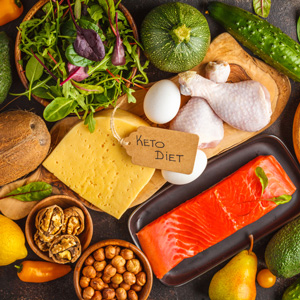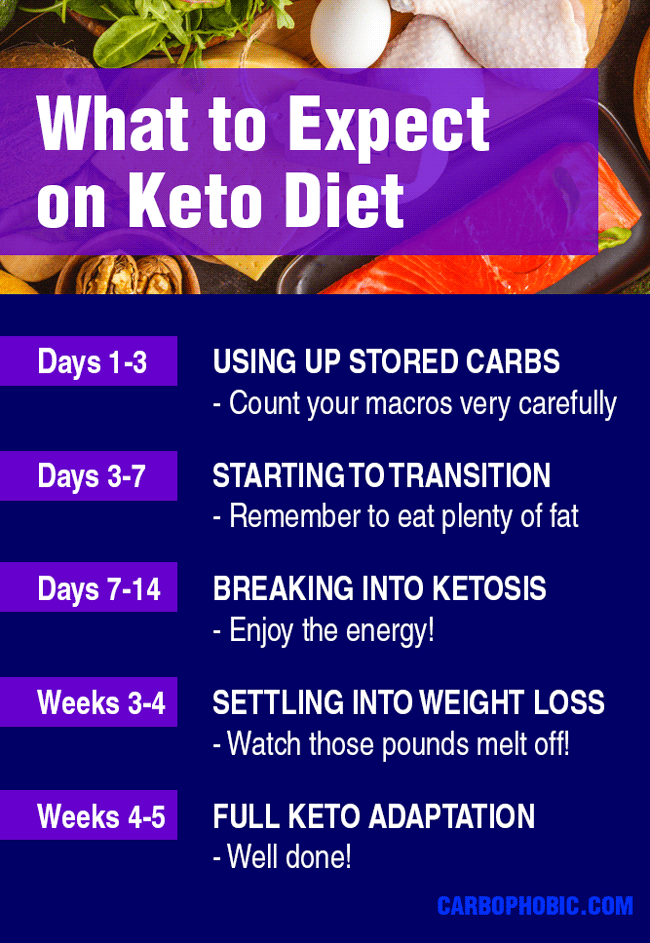
Keto Diet is growing more popular, with millions of devoted followers singing its praises.
One possible downside of this popularity is unrealistic expectations. As a first-timer, do you know exactly what to expect?
The truth is, Keto is not all plain sailing – especially in the beginning. For most people, it has to get worse (temporarily!) before it gets better.
Breaking into ketosis for the first time is well worth the effort – but it is not easy. Many first-timers are put off by the difficulties of the transition period. So they give up before breaking into ketosis and never get to experience its genuinely amazing benefits.
Here’s an honest guide to what you can expect when starting Keto for the first time.
Just remember that all difficulties are temporary – and there are many ways to make it easier.
The timescales below are approximate. They may differ by a few days for each individual.
Keto Diet Days 1-3: Using up stored glycogen
The first few days should be easy. You still have some carbohydrates stored in your body as glycogen.
During the first days of your Keto Diet, your body simply uses up those stored carbohydrates. So you won’t feel much different from pre-Keto.
At this stage, the most important thing is to count your carbs very carefully.
Related post: How to get your carb counts right
Keto Diet Days 3-7: Transition starts
After a few days of Keto, your glycogen stores run out. Your body is used to getting its energy from carbs. But you have cut most of them out. So your body is confused and unhappy. This is where you might start experiencing side effects like tiredness, headaches and Keto flu.
You might also experience very strong sugar cravings because your body is still demanding carbs.
It usually takes at least several days for your body to adjust to this new regime. This is the hardest period of the Keto Diet.
Most likely, you will not notice any weight loss yet at this stage. Some people report a small weight gain – this is a short-term fluctuation, so don’t panic.
At this point, it’s important to make sure you are eating enough fat to encourage the transition to ketogenic fat-burning.
Related posts:
Keto Diet Days 7-14: Breaking into ketosis
If your macros are definitely right, your body should now make the switch to burning fat for energy, instead of carbs. You break into ketosis!
Keto flu symptoms disappear completely. Your energy levels soar. You don’t feel hungry at all. Overall, you feel amazing.
Best of all, you start losing weight – faster than ever before. Some of this initial weight loss will be “water weight”. Carbs make your body retain water, and you lose some of those water stores when in ketosis. But you will already be losing actual fat as well.
Keto Diet Day 14 onwards: Smooth sailing
You settle down into your new diet. You are losing weight steadily, without feeling hungry.
Vigorous exercise, especially aerobic forms, may still be a bit difficult. It takes a few weeks longer for your body to become fully Keto-adapted, even after you are in ketosis.
The most important thing at this point is staying vigilant. Keep watching your macros carefully and avoid making common mistakes that might sabotage your Keto diet.
Keto Diet Weeks 4-5 onwards
You are now fully Keto-adapted. Your body became used to burning fat efficiently.
If you do aerobic exercise, like running or cycling, your performance will bounce back to pre-Keto levels – and may possibly even improve, especially for endurance-type exercise.
You are now gliding towards your ideal body quickly and without any hassle.
Well done!
Does everyone switch into ketosis within one week?
Most people switch into ketosis within 3-7 days of starting Keto Diet. But we are all different. Sometimes it takes longer, up to 2 weeks.
If you still haven’t switched into ketosis after 2 weeks, check your macros and consider taking supplements to speed up ketosis.
